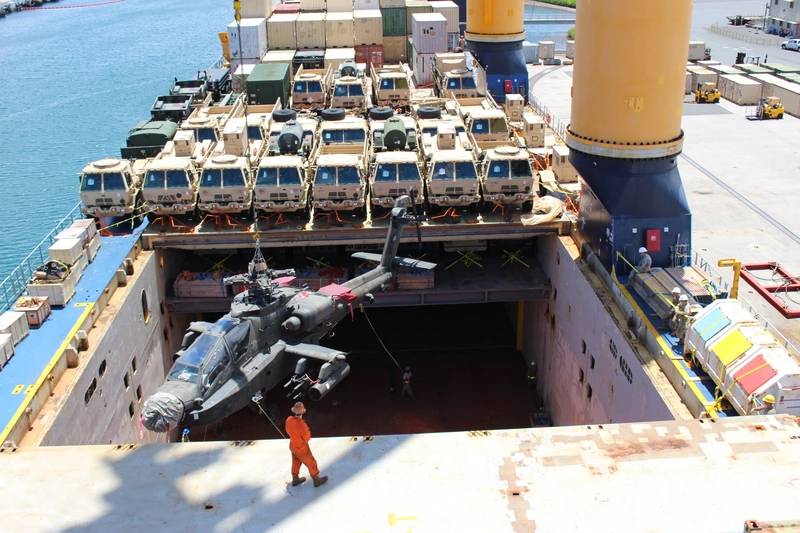Building the Next-Gen Maritime Prepositioning Ship & Auxiliary Crane Ship
The Military Sealift Command’s Maritime Prepositioning Ships (MPS) and Auxiliary Crane Ships (ACS) were built 50 years ago to pre-position vehicles and supplies in forward locations and load or unload them in undeveloped or damaged port facilities.
I serve with MSC’s Taluga Group, charged with finding innovative solutions to pressing problems. One of those challenges is meeting the MPS and ACS mission as the current ships continue to serve past their expected service lines.
To support distributed maritime operations (DMO) means we still need prepositioned material on vessels and the ability to handle their cargos, and we must anticipate the need to do so in a contested logistics environment.
Many of the MPF and ACS vessels employed today by the Navy provide Roll-On/Roll-Off (Ro/Ro) and/or Lift-On/Lift-Off (Lo/Lo) capabilities and have functioned very well. However, these vessels lack a Float-On/Float-Off (Flo/Flo) capability that could be used to support Expeditionary Advanced Base Operations (EABO) and Advance Naval Base (ANB) replenishment, heavy lift requirements, maintenance and repair vessel, transport barges or act as a mother ship for unmanned vessels. Moreover, these ships are old.
For example, the first of the five USNS 2nd Lt. John P. Bobo (T-AK 3008) class of roll-on/roll-off ships was completed in 1985, and chartered by MSC until 2007, when it was acquired by MSC. The 683-foot, 40,846-ton 2nd Lt. John P. Bobo is currently part of the U.S. effort to provide pier facilities to deliver humanitarian supplies to Gaza, but suffered an engine room fire while enroute to the Mediterranean, which may be indicative of the fragility of gaining sealift assets.
The ACS vessels are more than 50 years old and were converted to their current roles. The first, the 668-foot, 31,500-ton SS Keystone State (T-ACS 1) started life as a commercial breakbulk ship in 1965, and acquired by MSC in 1984 and converted to its current role.
As we recapitalize the prepositioning fleet, I propose the next generation of MPS and ACS vessels could not only be similar, but potentially even be the same vessel.
MSC has contracted for the use of J-Class “Open Hull” vessels to support Department of Defense missions in the past. They are heavy cargo, semi-submersible Flo/Flo, Ro/Ro and container-fitted Lo/Lo vessels. These ships might be more broadly described as maritime support vessels or multi-mission capable vessels, because they have great potential for a spectrum of military support missions.
 M/V Ocean Jazz can be configured to carry containers, vehicles and even aircraft. Seen here she employs her forward crane to lift an Apache helicopter into the hold during port operations at Pearl Harbo, Hawaii. (Military Surface Deployment and Distribution Command photo by Donna Klapakis)
M/V Ocean Jazz can be configured to carry containers, vehicles and even aircraft. Seen here she employs her forward crane to lift an Apache helicopter into the hold during port operations at Pearl Harbo, Hawaii. (Military Surface Deployment and Distribution Command photo by Donna Klapakis)
The existing well deck could be modified to add vertical watertight bulkheads, tween deck, and hatch covers. It should be fitted for dangerous cargo as defined by International Maritime Organization (IMO) Safety of Life at Sea (SOLAS), and smoke detectors, CO2 system and a sprinkler system should be installed. The stern ramp would permit vehicles access to the well deck, and additional ramps can provide access to the tween deck and the maindeck.Flo/Flo capabilities would allow transporting of numerous military related items, such as Navy or Coast Guard patrol boats, landing craft or the Improved Navy Lighterage System (INLS).
Additionally, we would require a vessel with a few large cranes that can conduct a 350-ton lift; with the ability to support container handling from other container ships.
By adding a dynamic positioning system (DP2), compensating cranes, berthing modules, tween decks and Flo/Flo capability would allow her to maintain station without having to anchor in most sea states; safely discharge cargo to other vessels while her load remains relatively stable; load and discharge the INLS, and serve as a crane ship and floating pier in austere ports.
Both DP2 and compensating cranes are commonly used in the oil platform and wind farm industry; this technology already exists and would enhance the Navy and Marines’ capabilities.
The current MPS and ACS fleet are larger vessels that what we envision here. By comparison with MSC’s T-AKRs and T-AKs, the vessels on the commercial market today are smaller but bring additional capabilities. To obtain this capability quickly, existing commercial ships can be converted. Eventually, the Navy should look at a newer version built in U.S. shipyards for the sealift fleet. U.S. yards are up to the task, and building these types of ships would be a boost to the U.S. ship construction industry.
A class of “Open Hull” heavy cargo, semi-submersible Flo/Flo, Ro/Ro and container-fitted Lo/Lo vessels would provide the Navy and Marine Corps a range of versatility that permits different configurations, and would be suitable replacements for the MPS ships in our Naval inventory.




















